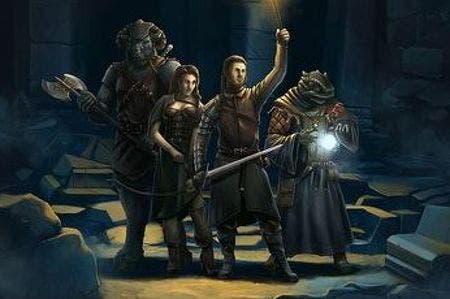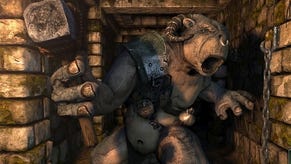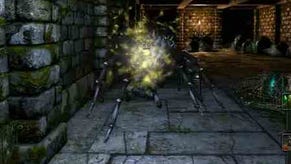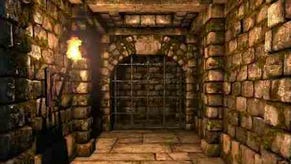Legend of Grimrock Review
Square deal.
The square is a great shape, and one that is criminally underused in modern game design. The square is dependable and robust. You always know where you are in a square, with its clearly defined boundaries. In the push to ever more granular, chaotic environments, games have lost sight of the simple pleasures of right angles and straight lines.
Legend of Grimrock is a very square game. Don't let the first-person perspective fool you. You won't be circle-strafing around the monsters in this one. It's a dungeon crawler, a role-playing game in the classic sense where you create a party of four characters and then guide them through a gloomy enclosed location, grabbing every item and killing every monster. There are no characters to romance, no side quests to complete, no quests at all in fact. Your goal is as tried and true as the squares that make up its labyrinthine map: get out.
Movement around the map is chunky. Step forward and you move to the square ahead. Sidestep or back pedal and your range is the same. Rotation comes in reliable 90-degree swoops. You'll always know exactly what you can do, but don't think that means the game is a simple A-to-B stroll. At the start you can opt to play in something called Old School Mode, which switches off the automapping and puts the responsibility for tracking your progress, one square at a time, in your hands. "Arm yourself with a stack of grid paper and pencils," says the game, "and prepare to get lost."
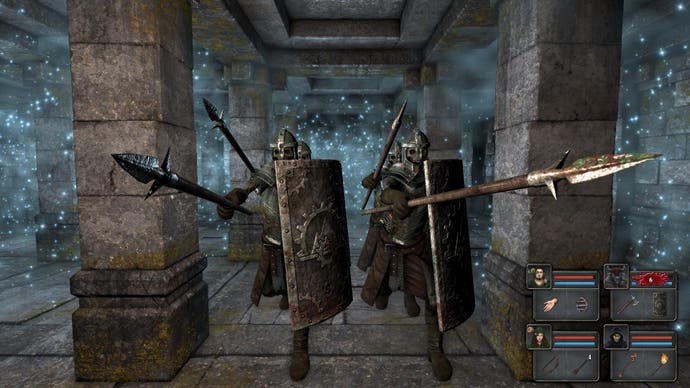
Interaction is every bit as simple as movement, with everything you need to do handled by intuitive point-and-click controls. Inventory items are easily grabbed from the environment and dropped into the open-handed icons of your characters, or deposited in backpacks. Moving them around is just as simple. Click, pick up, move, drop. When you get your hands on a mortar and pestle, brewing potions is similarly immediate. Drop a flask and the relevant herbs into the pestle's window (squares, of course) and your potion appears.
Traditional RPG foes such as giant snails, skeletons and spiders occupy the square ahead and you right-click away on the equipped weapons in your party to strike back. Such encounters become harder when multiple enemies appear, and it's here that the geometric construction of the game can feel restrictive to modern eyes. It's very easy to get boxed in and slaughtered from all sides, while manoeuvring out of harm's way can be a clunky affair. It's not so much a problem with the game itself, more a need to retrain your twitching thumbstick fingers to adapt to a style of fighting that has passed out of favour. The satisfaction gained from outwitting a quartet of armoured skeletons makes the effort worthwhile.
Ranged weapons - stones, knives, shuriken - can be thrown, while using a bow is as simple as holding the arrows in your other hand. Magic is less intuitive, requiring specific skill points in the relevant elemental fields, and combinations of runes to be highlighted before you can unleash a spell. It's a little clumsy, but the impact is so powerful that, as always, protecting your mage becomes a priority.
You can press R to rest after battles, refilling health and stamina, but that's about it as far as concessions go. It's not Dark Souls hard, but it is a game that will gladly sit back and watch you paint yourself into a corner, either through poor inventory management, inept party make-up or bad levelling decisions.
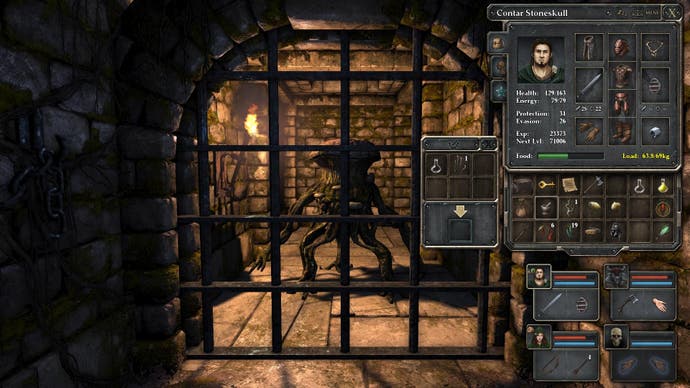
In keeping with the pared-back approach elsewhere, the skill trees for each of the expected classes - fighter, rogue mage - are simple but require some thought. The truly powerful abilities are tucked away at the top of each tree, while levelling is infrequent enough that you'll never be able to max everything out. Being a jack-of-all-trades means compromising your power considerably, while specialising in one field - swords over maces, fire magic over ice - can leave you at a disadvantage. It's tough, sometimes a little unfair, but a game where the player is never protected from the consequences of their choices. Like a table-top RPG, you just have to roll the dice and make the best of what you've chosen.
At its heart, though, Legend of Grimrock is more interested in puzzles than pugilism. The story is nothing that couldn't be scribbled on the back of a character sheet - you've been wrongly condemned to a mountain prison and are occasionally guided by a mysterious voice. Even combat, central as it is to the game, is ultimately something that happens on the way to the next locked door.
It's here, at the dead end, that the game stretches its muscles, necessitating a hunt for hidden keys, the solution to a cryptic riddle or just scouring the walls and floors for secret levers, moving panels and pressure pads. Things start simple, but soon you'll be scratching your head at each impasse, trying to resist the urge to head to YouTube for a solution.
The fact that the community has already started filling the internet with hints and walkthroughs speaks highly of how quickly and conclusively Legend of Grimrock has found its place in the gaming landscape. This is very much a game that owes its existence to the new era of digital publishing: an entry in an abandoned niche, made by talented fans for the benefit of fellow enthusiasts. Grimrock's systems and rules are evident for all, but if the words "Eye of the Beholder" hold no meaning for you, its appeal may be harder to pin down.
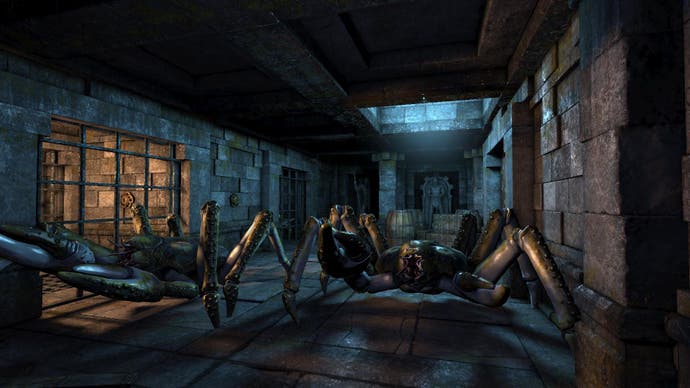
Finnish indie Almost Human has been clever with the way it deploys its resources. The game looks good but you can see where time has been saved. Wall textures and objects repeat constantly, while monster animations are copy-pasted so that larger groups can look like some kind of infernal line-dancing troupe as they advance. But none of that matters. Rather than feeling cheap and repetitive, it all helps to maintain the focus. The only time you're left confused or unsure as to what something does is when the developer wants you to be mystified. The environment - visually and aurally - becomes a series of instinctively readable cues that guide you.
Legend of Grimrock walks a very fine tightrope with outrageous confidence. With its ruthless adherence to 1990s design it shamelessly panders to nostalgia, but it never feels like it relies on that inherited fondness to get by. That's a trap too many retro-inspired indies fall into: letting the past do all the work to mask holes in the design. Grimrock doesn't do that. It reminds us that the old ways still have value, but its thoughtful construction and nuanced balance ensure that it can still stand on its own two feet in 2012 and justify its existence on its own terms.
Middle-aged role-players should need no encouragement to plunge into Grimrock's depths, but for new players discovering the genre through sprawling epics like Skyrim, its robust reliance on the strength of squares will make it a refreshing experience.
